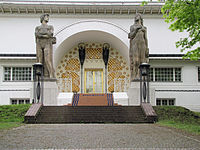
Back Jugendstil German یوگنداشتیل Persian Jugendstil French יוגנדסטיל HE Jugendstil Italian ユーゲント・シュティール Japanese იუგენდსტილი Georgian Jugendstil NN Jugendstil Portuguese Jugendstil Romanian
This article needs additional citations for verification. (January 2021) |
Top: Ernst Ludwig House at the Darmstadt Artists' Colony; Center: cover of Jugend magazine by Otto Eckmann (1896); Bottom: Dining room of Peter Behrens in Darmstadt (1900–1901) | |
| Years active | c. 1896–1914 |
|---|---|
| Location | Germany |
Jugendstil (German pronunciation: [ˈjuːɡn̩tˌstiːl] ⓘ; "Youth Style") was an artistic movement, particularly in the decorative arts, that was influential primarily in Germany and elsewhere in Europe to a lesser extent from about 1895 until about 1910.[1] It was the German counterpart of Art Nouveau. The members of the movement were reacting against the historicism and neo-classicism of the official art and architecture academies. It took its name from the art journal Jugend, founded by the German artist Georg Hirth. It was especially active in the graphic arts and interior decoration.[2]
Its major centers of activity were Munich and Weimar and the Darmstadt Artists' Colony founded in Darmstadt in 1901. Important figures of the movement included the Swiss graphic artist Hermann Obrist, Otto Eckmann, and the Belgian architect and decorator Henry van de Velde. In its earlier years, the style was influenced by the British Modern Style. It was also influenced by Japanese prints. Later, under the Secessionists' influence, it tended toward abstraction and more geometrical forms.[1]
- ^ a b Encyclopedia Britannica On-Line edition, Jugendstil
- ^ "Jugendstil: Art Nouveau in Germany". www.visual-arts-cork.com. Retrieved 2023-05-22.


